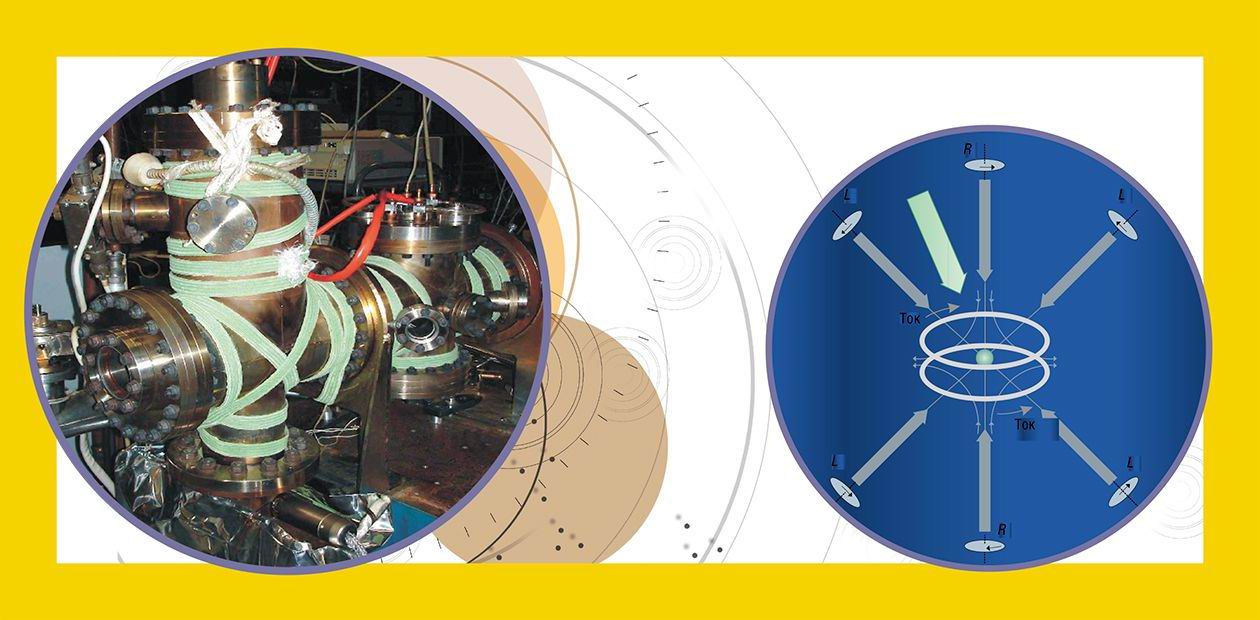New Time
Scientists of the Institute of Laser Physics SB RAS (Novosibirsk) are carrying out pioneering research on creating the new generation of frequency standards on the basis of high-stable laser and ultra-cold atoms. Ultra-narrow absorption lines of the atoms of alkali-earth elements cooled and localized with laser radiation will help to develop in the near future a primary standard of one of the main physical quantity - time
Measuring various quantities forms a basis of all modern science and technology. To measure is to compare a quantity with an etalon (standard). Without standards it would be impossible to make accurate measurements.
Frequency standards occupy a special place in this domain. They play a most important role in both fundamental research and various metrological and navigational applications. It is related, first of all, to the fact that frequency standards, which, since 1967, has realized the etalon of one of the main base unit of SI-system, the second, are by several orders of magnitude more accurate than other standards.
At present, the primary frequency standard is based on the stable transition (9.2 GHz) between the sub-levels of the hyperfine structure of an atom of cesium-133. The International scale of atomic time TAI is based on this standard.
Atomic frequency standards of the microwave range are widely used in the navigational systems GPS and GLONASS, where compact cesium and rubidium devices with the relative precision 10-13 (frequency drift per 24 hours) are mounted on each satellite of the system, and hydrogen devices with the long-term stability of about 10-14 are installed on the earth tracker stations. High precision of coordinate determination with the help of these systems is reached mainly due to frequency precision.
We should note that precision of the cesium frequency standard has increased as compared with its first realization by five orders (!) and has probably reached its limit. The precision of about 4×10-16 achieved today for the stationary setups with the use of a “fountain” of cold atoms is limited by fundamental physical reasons, such as frequency shift due to atomic collisions, thermal radiation, gravitation shift, etc.
Experts believe that a further increase in precision could be possible if we left the microwave range for the optical one. An important advantage of optical standards is their potentially high stability in short times (0.1—100 s), which should allow much faster measuring. As a reference, we suggest to use narrow resonances in absorption of ultra-cold (temperature about 1 µK) and localized (trapped) into electromagnetic and optical traps single ions and assemblies of neutral atoms.
The studies became much more topical lately due to the progress in the field of optical frequency synthesizers based on femto-second lasers*. Methods of atom cooling and localizing with the help of laser radiation have been successfully developed in the last two decades. The use of “slow” atoms eliminates or significantly decreases systematic errors caused by the motion of atoms, and the time of the atoms’ interaction with the radiation significantly increases, which leads to the narrowing of the absorption lines
How can the atom be slowed down? The simplest mechanism is the force of spontaneous light pressure. When an atom absorbs laser radiation directed at it, during a cycle of absorption and the following spontaneous radiation, it receives, on average, a momentum in the direction opposite to its movement. In other words, it is decelerated. Even though in one cycle the velocity changes insignificantly (by several centimeters per second) whereas the initial velocities are several hundred meters per second, thermal atoms are decelerated quite effectively due to the high speed of optical transitions (108 —109 cycles per second).
Very promising is the geometry of six laser beams propagating in three mutually perpendicular directions with frequency detuning to the “red” side in relation to the resonance. The system should be supplemented by a magnetic field of a certain configuration, which also promotes atom localization. This device has a special name – magneto-optical trap (MOT). Thanks to the mechanism of spontaneous light pressure, part of the atoms “loaded” into the trap from the thermal beam will be decelerated, cooled down and localized in the MOT’s geometrical center.
Of special interest for creating the new generation of optical frequency standards are atoms of alkali-earth elements (magnesium, calcium, strontium, and ytterbium) with narrow absorption lines. The Institute of Laser Physics SB RAS has laid special emphasis on the studies of ultra-cold atoms of magnesium. The high-vacuum chamber of the MOT developed together with the Institute of Semiconductor Physics SB RAS allows us to achieve a pressure of residual gases less than 10-8 Pa. The unique laser system emits continuous narrow-band radiation tunable in frequency in ultra-violet range at the wavelength of 285 nm.
As a result of the experiments, the scientists have obtained a cloud of 105 —106 atoms of magnesium at the temperature 3—4mK. The linear size of the atom cloud is about 0.5 mm. Note that it is the first magneto-optical trap for alkali-earth atoms realized in Russia.
Now works on further cooling of magnesium atoms (down to 10-5 K) continue at the Institute of Laser Physics. Scientists aspire to succeed by trapping atoms in the so-called optical lattice, i. e., nodes or antinodes of the standing electromagnetic wave. It would allow eliminating completely the influence of the atoms’ residual motion on the precision of the developed frequency standard, which should reach 10-17 —10-16 .
* 1 fs = 10-15 s





